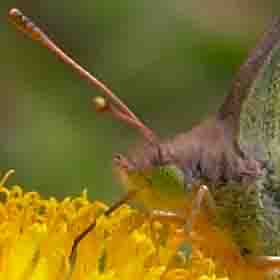JPEG
Images: Counting your Losses
Standard and "Not so
Standard" Formats
Digital photos can be stored in
many formats such as JPEG, TIFF, PNG, PSD, PCD and many
others. It is important to understand the limitations of
each format so that you can select the proper format for
the job at hand. This article focuses on the costs and
benefits of using the JPEG format, so we won't go into
all of the other possible formats in detail, at least not
in this article. Of all the dozens of popular formats,
some are proprietary and others are considered "international
standards". Using a format that is an international
standard ensures that you and the people with whom you
share images will be able to display them without needing
additional software in most cases. Three of the most
popular "international standard" formats used
on the web are JPEG, TIFF, and GIF. GIF is limited to 256
colors and is used most often to display screen shots and
graphs and should not be used for photographs. The
remaining formats, JPEG and TIFF, both have their place
in digital photography and there are pros and cons to
both formats.
Lossy and Lossless Formats
TIFF, often saved with a TIF file
extension, is a lossless format. Lossless means that when
the image is saved and later reloaded, each pixel in the
saved/reloaded image is identical to the image before it
was saved. As such, there are no quality losses, but the
size of the file can be quite large because the RGB
values for each pixel are recorded verbatim. Compressed
TIFF's offer a size savings just as WinZip offers size
savings for files, without introducing quality loss but
even compressed TIFF's are usually larger than JPEG
images.
JPEG on the other hand, is a lossy
format. Lossy means that compromises are made to allow
some image quality to be lost each time the image is
saved. In return for the slight quality loss, the file
size can be much smaller, on the order of 2-10 times
smaller than a compressed TIFF. When an image is saved in
the JPEG file format and later reloaded, the saved/reloaded
image will not be identical (pixel to pixel) to the
original before it was saved. Fortunately, the quality
losses can be very difficult if not impossible to detect
with the unaided eye after only a single save. Keep in
mind that repeatedly opening and resaving JPEG photos
will incur cumulative losses with each save, making
quality worse each time you resave the JPEG.
Understanding "Compression"
and "Quality"
When saving JPEG images, you will
normally have a choice of either "quality" or
"compression". The higher the compression, the
lower the quality because when you compress more (to
reduce file size), quality decreases. Just remember that
if your photo editor lets you choose "quality"
for your JPEG's, higher values will produce bigger files
with higher quality. If, on the other hand, your JPEG
options include "compression", higher values
for "compression" will result in smaller files
of lesser quality.
Getting a Handle on
Quality Losses
There are two types of losses
associated with saving JPEG images. The first type of
loss is simply related to the parameters you use when you
save the file: set your compression too high or your
quality too low, and your images will look worse. The
second type of losses are "generational" losses.
Generational losses occur when you repeatedly open and
resave JPEG files, opening a file, saving it, opening the
second copy, saving it to a third file, etc. The greater
the number of times you save the JPEG (from a previous
copy), the worse your images will look. The first time
you save an image to a JPEG, it can be considered a
"first generation" JPEG. If you open that first
generation JPEG and resave it, the resaved file can be
considered second generation since it has gone through
the JPEG lossy saving method twice. Remember that losses
only occur in the saving process. Repeatedly opening
an already saved JPEG without resaving it (modifying
it) isn't going to cause losses in quality. Losses are
only incurred when you use the "File", "Save"
or "Save As" command and you choose "JPEG"
as the file type.
Examples of JPEG Quality
Loss
Here is an example that
demonstrates visible loss of image quality due to saving
the same image at different quality settings. The
following images were saved using PhotoShop and quality
settings between 0 (low quality, small files) and 12 (highest
quality, largest file size). As you can see, the lowest
quality produces the smallest file size but there are
highly visible artifacts in the image such as color
blotching, pixelization, and posterization (banding) of
colors. As you increase quality, these artifacts start to
disappear, but file size increases as an inevitable cost.
Note that once you get to about quality 10 or higher, it
is nearly impossible to distinguish between the JPEG and
the original image (before saving to JPEG) for most
images. As a result, as long as you save at a high
quality (low compression) setting, JPEG is certainly a
valid format for a "first generation" save and
can rarely be distinguished from a lossless save such as
a TIFF image as long as a high quality setting is used.
| Save Quality |
File Size |
Result |
| 12 |
87KB |
 |
| 11 |
66KB |
 |
| 10 |
52KB |
 |
| 9 |
44KB |
 |
| 8 |
40KB |
 |
| 7 |
36KB |
 |
| 6 |
35KB |
 |
| 5 |
33KB |
 |
| 4 |
31KB |
 |
| 3 |
30KB |
 |
| 2 |
28KB |
 |
| 1 |
27KB |
 |
| 0 |
26KB |
 |
Below is an example of
"generational losses" from opening and resaving
in the JPEG format. Notice that quality is very
reasonable for the first few saves but losses become
evident beyond about 5 saves depending on the quality
setting used. Below, "generation" indicates how
many times the JPEG has been resaved based on saving copy
1, opening copy 1 and saving copy 2, opening copy 2 and
saving copy 3, etc. Notice how the generational losses
are less evident when you save each copy with a higher
quality setting. The quality differences are more subtle
with generational losses when compared to simply picking
the wrong quality level (above), but by the 10'th
generation, obvious blotching and color changes are
occurring.
| Generation |
Save Quality 10 |
Save Quality 12 |
| 1 |
 |
 |
| 2 |
 |
 |
| 3 |
 |
 |
| 4 |
 |
 |
| 5 |
 |
 |
| 6 |
 |
 |
| 7 |
 |
 |
| 8 |
 |
 |
| 9 |
 |
 |
| 10 |
 |
 |
What about JPEG 2000?:
There is a newer and less [visibly]
lossy version of the JPEG format known as JPEG 2000,
often saved with a J2K or JP2 file extension. The JPEG
2000 format has similar issues when compared to the JPEG
format but to a lesser degree. In addition, the JPEG 2000
format offers a "lossless" mode in which images
can be saved without any quality loss, but with a
somewhat larger file size. In general, JPEG 2000 offers
higher quality than JPEG when comparing the same saved
file size. So why not use JPEG 2000? Many people are,
however, JPEG 2000 is not as widely supported and is
generally much slower than JPEG. In addition, if you have
a camera and you shoot in JPEG mode where your camera
delivers a JPEG file on the memory card, there is no
benefit to resaving those JPEG images to JPEG 2000 images
since that will incur further quality losses over the
original JPEG, unless you use the lossless JPEG 2000 mode
which will serve to do nothing but increase file size
over the original JPEG. In general, JPEG is just easier
to use, more portable, faster, and can be readily
displayed quickly on the web, in email clients, and other
third party applications. With time, JPEG 2000 decoders
will get faster, will be more widely available, and more
tools will support them, possibly even some future
cameras. So far, the JPEG 2000 format really hasn't
"taken off" in the industry like was
anticipated, but time will tell.
What's the Bottom Line?:
The JPEG image format offers a way
to save images using less space, but with some loss in
image quality. Typically, a first generation save will be
almost as good as a lossless TIFF as long as you use
quality levels close to the highest available. Some
"die hards" claim that you should never use a
camera in JPEG mode when you have TIFF or RAW available
as an option, and one cannot argue that you get the best
quality and best editing capability with TIFF or RAW when
compared to JPEG. That said, JPEG is a perfectly valid
format to use even when capturing images the first time
in your camera, especially when memory space, shooting
speed, or the ability to print images without post
processing is important. Remember that JPEG's are
processed and ready to view/print, whereas RAW images
require post processing to "develop" the images
from the raw data. This takes additional time and can
complicate your shoot-to-print workflow. A first
generation JPEG will offer quality comparable to any
other final or ready-to-print format, however, cannot
offer latitude for correcting exposure and other shooting
issues like a RAW image or a 48 bit TIFF. Bottom line:
choose what works for you, but be sure to take the pros/cons
of each format into consideration.
Mike Chaney


 Qimage registration expired? New lifetime licenses are only $59.99!
Qimage registration expired? New lifetime licenses are only $59.99!


 Qimage registration expired? New lifetime licenses are only $59.99!
Qimage registration expired? New lifetime licenses are only $59.99!